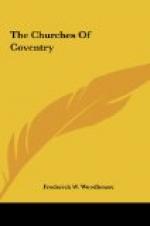Soon after this, in 1423, Coventry showed its sympathy for Lollardry when John Grace an anchorite friar came out of his cell and preached for five days in the “lyttell parke.” He was opposed by the prior of St. Mary’s and by a Grey Friar who however were attacked and nearly killed by the mob.
The royal visits which earned for Coventry the title which it still bears as its motto ‘Camera principis’ were frequent in this century. In 1436 we hear of Henry VI being there, and in 1450 he was the guest of the monastery and after hearing mass at St. Michael’s Church presented to it for an altar-hanging the robe of gold tissue he was wearing. The record in the Corporation Leet book is interesting enough to quote:
The King, then abydeng stille in the seide Priory, upon Mich’as even sent the clerke of his closet to the Churche of Sent Michel to make redy ther hys clossette, seying that the Kynge on Mich’as day wolde go on p’cession and also her ther hygh masse. The Meyre and his counsell, remembering him in this mater, specially avast hem to pray the Bishop of Winchester to say hygh masse afore the Kynge. The Bishop so to do agreed withe alle hys here; and, Aegean the Kynge coming to Sent Michel Churche, the Meyre and his Peres, cladode in scarlet gowns, wanton unto the Kynge Chamber durra, ther abydeng the Kynge coming. The Meyre then and his Peres, doing to the Kynge due obeisance ... toke his maze and here it afore the Kynge all his said bredurn goeng afore the Meyre til he com to Sent Michels and brought the Kynge to his closette. Then the seyde Bishop, in his pontificals arayde, with all the prestes and clerkes of the seyde Churche and of Bablake, withe copes apareld, wanton in p’cession




